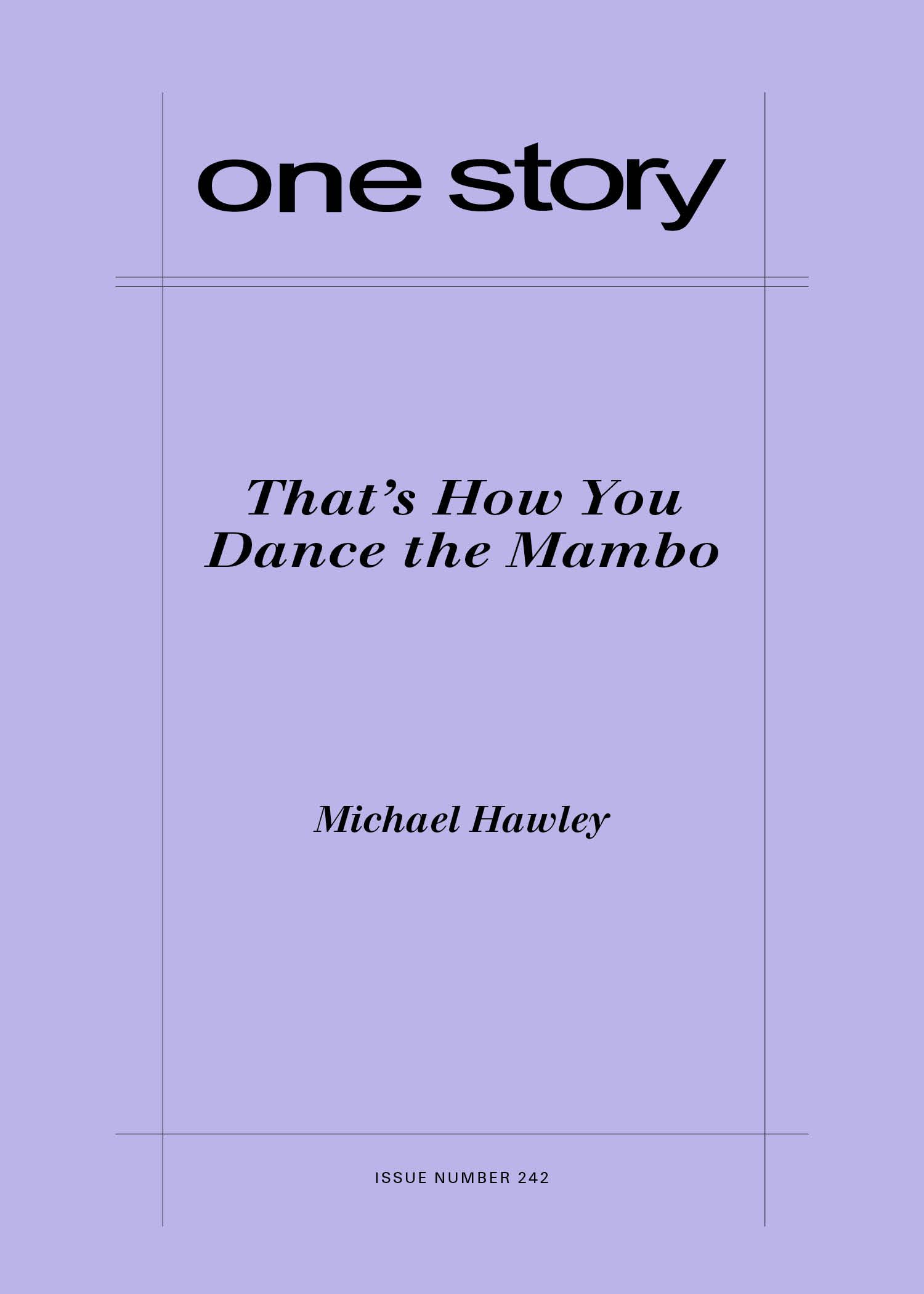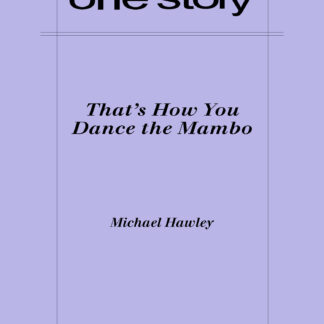
That’s How You Dance the Mambo
$2.50
99 in stock
Excerpt
There is something Albert has to do for someone. It was there just a moment ago, the way a thread once wrapped around a finger leaves a mark. He can sense the fading shape of it. But who asked? And was it important?
His eyes come to rest on the coffee table, light reflecting from its dusty glass top. An open handbag sits on a corner of it—a frame-style bag in red patent leather. A woman brushes past him in a khaki trench coat. She walks to his apartment door with such purpose he thinks she must be leaving.
“You should keep this closed, Al, with all the construction dust.”
As if on cue, the itch in Albert’s throat returns. Coughing, he watches her close the door and snap the deadbolt. She is tall, thick-waisted, her bobbed sable hair capped with a purple beret. When she turns, he knows her. Her name starts with M.
“With all the workmen in and out,” she says, “anyone could be walking the halls. Like that old bearded guy with the baseball bat loitering on the stoop.”
Albert clears his throat. “He’s younger than I am, thank you very much.”
“Well, who is he?”
“Nestor. He lives here. Nestor Colón.”
“He was holding that bat like a weapon.”
“Old habits.” Albert chuckles. “If it’s any comfort, he’s practically blind.”
Michael Hawley
Michael Hawley’s short stories have been published in Alaska Quarterly Review, Boston Review, Cimarron Review, The New Yorker, Post Road Magazine, The Southern Review, and elsewhere. He lives in New York City.
Patrick Ryan on “That’s How You Dance the Mambo”
I’ve lived in New York City for twenty years, and I’ve seen it change an awful lot. But say that to someone who’s lived here for thirty, forty, fifty years or more, and they’ll laugh, roll their eyes, and wave your observations away. Then they’ll tell you what real change looks like.
The main character in Michael Hawley’s “That’s How You Dance the Mambo” is Albert, an elderly man who is doing his best to live in the moment, even while the moment rains plaster dust down on his head. Most of his dear friends have shuffled off the mortal coil. His landlord would love for him to give up his apartment. His nephew wants to move him into a retirement home outside of the city. And his longtime neighbor, Nestor, has found a hundred-dollar bill and wants to go to dinner—but that means venturing out into a landscape neither one of them feels comfortable calling home.
“That’s How You Dance the Mambo” is a rendering of a present that’s out of true with its past. It’s a faded and crumbling love letter to New York City, and it’s a story, as the author says in our Q&A, about resilience. Let the dance lesson begin.
Q&A by Patrick Ryan
- PR: Where did the idea for this story come from?
- MH: Maybe six years ago I read an article about Taylor Mead (actor/poet/Warhol associate) and how the landlord of his Lower East Side tenement tried various tactics to get him out of the rent-stabilized apartment he lived in for decades. That, together with the personality of Mead himself (I heard him read at the Bowery Poetry Club a few times), was the genesis of the story.
- PR: You capture old New York City vs. new New York City in a very touching and sad way. And the details are spot-on. Have you lived in the city for a long time and seen a lot of change?
- MH: I have lived in the East Village for many years. Let’s just say I’m thankful I moved here before the corporate takeover bled Manhattan of so many of its unique offerings.
- PR: I don’t know if I’ve ever read an account of a friendship quite like Albert and Nestor’s. One of them, decades ago, severely beat the other in what we would now call a hate crime. And yet here they are, looking out for each other. Was that friendship always going to be a large component of the story? Or did it emerge once you got underway?
- MH: Initially, the story’s focus was on Albert’s relationship to the deceased Elaine. As often happens, I’ll start a piece and then set it aside “to think.” That point happened after Albert’s first encounter in the story with Nestor in the hallway. When I came back to the story six months later I knew the general direction it would take, and that the relationship between the two men was “complicated.” They are in a situation where they have to depend on each other to some extent, but aside from what is happening with their building, both men are from backgrounds that diverge from the dominant culture—one ethnically, the other sexually. Both were treated by the dominant culture in ways more or less expected by their generation. Marginalization was accepted as a fact of life—and perhaps as a point of pride. I may be wrong, but I also feel it protected their own sense of identity/culture in the context of the NYC melting pot. What I’m getting at is that they understand each other’s plights within certain bounds, and in understanding lies an inherent kind of forgiveness. And Albert, don’t forget, still has a romantic attraction to Nestor, nostalgic and vestigial as it may be.
- PR: How did you approach writing about Albert’s dementia? It seems like it would be very easy to overwrite such a thing. And a big risk there, along with allowing it to dominate the story, is the potential confusion it might cause for the reader. You’re very good at preventing Albert’s dementia from becoming our dementia. Was that a challenge?
- MH: This aspect was not a challenge. For me the dementia was the key into Albert’s character, which then came pretty much whole cloth; what he keeps remembering says a lot about the kind of person he is. A careful negotiation between omniscient narrator and close third hopefully keeps the reader both grounded and empathetic.
- PR: It’s heartbreaking to see a character like Albert endure the conditions of his dilapidated apartment and the neglect of his landlord. Can you explain for those of our readers who don’t live in a big, overcrowded city what a “buyout” is, and why Albert hasn’t just taken the money offered?
- MH: The buyouts—offers to lure tenants into breaking their rent-stabilized leases—are rarely very generous; not enough for someone to purchase a comparable place, and certainly not in the same neighborhood. In New York your neighborhood is everything—or used to be, when neighborhoods still had distinct characters due to the nature of the diversity present, local businesses, longtime neighbors, characters. Albert would wither quickly outside of his milieu, which carries so much for him personally, if mostly symbolically. I’m pretty certain that he didn’t go to the facility in New Jersey; he died in his tenement building.
- PR: Finish this sentence in just one word—the word you think best captures it: “This story is about __________.”?
- MH: Resilience. For me, it’s about resilience in the face of circumstances. Some people have said they find the story depressing, but I don’t feel that way. Age, debilitation, and loneliness are depressing, sure, but Albert never feels sorry for himself, not for one second. He is a contented man and a pleasure to know.
- PR: What are you working on now?
- MH: More stories and a longer work.
- PR: What is the best bit of advice about writing you have ever received?
- MH: Write harder.
